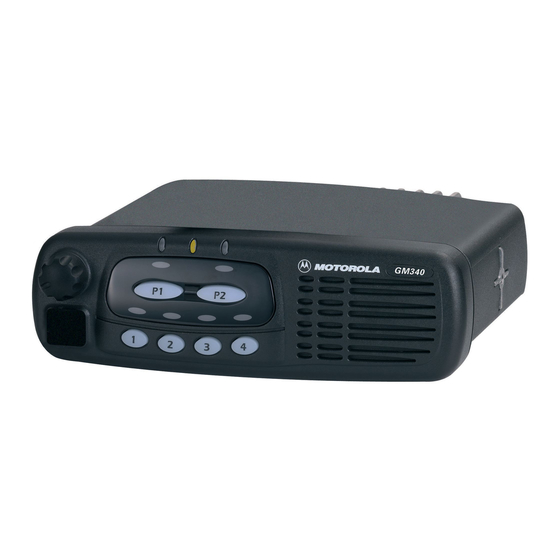Motorola GM640 서비스 정보 - 페이지 15
{카테고리_이름} Motorola GM640에 대한 서비스 정보을 온라인으로 검색하거나 PDF를 다운로드하세요. Motorola GM640 34 페이지. Gm series professional radio uhf (403-470mhz)
Motorola GM640에 대해서도 마찬가지입니다: 사용자 설명서 (28 페이지), 서비스 정보 (32 페이지), 서비스 정보 (32 페이지)

VHF (136-174MHz) Transmitter Power Amplifier (PA) 25 W
3.5
Antenna Switch
The antenna switch consists of two PIN diodes, D3471 and D3472. In the receive mode, both diodes
are off. Signals applied at the antenna jack J3401 are routed, via the harmonic filter, through
network L3472, C3474 and C3475, to the receiver input. In the transmit mode, K9V1 turns on Q3471
which enables current sink Q3472, set to 96 mA by R3473 and VR3471. This completes a DC path
from PASUPVLTG, through L3437, D3471, L3472, D3472, L3471, R3474 and the current sink, to
ground. Both diodes are forward biased into conduction. The transmitter RF from the directional
coupler is routed via D3471 to the harmonic filter and antenna jack. D3472 also conducts, shunting
RF power and preventing it from reaching the receiver port (RXIN). L3472 is selected to appear as a
lambda / 4 wave transmission line, making the short circuit presented by D3472 appear as an open
circuit at the junction of D3472 and the receiver path.
3.6
Harmonic Filter
Components L3491-L3493 and L3472, C3491-C3499 form a Chebychev low-pass filter to attenuate
harmonic energy of the transmitter to specifications level. R3491 is used to drain electrostatic
charge that might otherwise build up on the antenna. The harmonic filter also prevents high level RF
signals above the receiver passband from reaching the receiver circuits, improving spurious
response rejection.
3.7
Power Control
The transmitter uses the Power Control IC (PCIC, U3501) to control the power output of the radio. A
portion of the forward RF power from the transmitter is sampled by the directional coupler and
rectified, to provide a DC voltage to the RFIN port of the PCIC (pin 1) which is proportional to the
sampled RF power.
The ASFIC (U0221) has internal digital to analog converters (DACs) which provide a reference
voltage of the control loop to the PCIC via R3505. The reference voltage level is programmable
through the SPI line of the PCIC. This reference voltage is proportional to the desired power setting
of the transmitter, and is factory programmed at several points across the frequency range of the
transmitter to offset frequency response variations of the transmitter's power detector circuit.
The PCIC provides a DC output voltage at pin 4 (INT) which sets the drain current of the first
(U3401) and second (Q3421) transmitter stage via current control op-amps U3402-1 and U3402-2.
This adjusts the transmitter power output to the intended value. Variations in forward transmitter
power cause the DC voltage at pin 1 to change, and the PCIC adjusts the control voltage above or
below its nominal value to raise or lower output power. Capacitors C3502-4, in conjunction with
resistors and integrators within the PCIC, control the transmitter power-rise (key-up) and power-
decay (de-key) characteristic to minimize splatter into adjacent channels. U3502 is a temperature-
sensing device, which monitors the circuit board temperature in the vicinity of the transmitter driver
and final devices, and provides a dc voltage to the PCIC (TEMP, pin 30) proportional to temperature.
If the DC voltage produced exceeds the set threshold in the PCIC, the transmitter output power will
be reduced so as to reduce the transmitter temperature.
2-5
